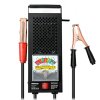Bogdanphb
New Member
Hi guys,
I have the following problem with the bike and I don't really know what to change. I've noticed the battery gets to the point where it's that weak it won't start the bike. It happens if I stall the bike a couple of times without any high RPM ride or I practice slow speed drills for about 15-20 mins and then shut the engine and start again repetitively. Basically, what the bike tries to tell me, if you stop and start the engine multiple times 3-5 times within a short period of time or if not going up to 5k RPM the battery will not be flat but won't have enough V to start the bike.
Today when I faced the problem, after a series of slow speed drills, went to a ride for 10min with higher RPM, shut the engine, started again, went slow RPM through a pedestrians area, had to shut the engine again and walk beside the bike before I would get a fine, when I tried to start it wouldn't start. Checked the diag for battery V, 11.5V. Had to basically just walk beside the bike for 10-20mins to get some passive power, eventually it started down a slight hill. When I got home after 30mins of riding at no less than 5k RPM, D:09 showed the battery has 11.9V. In diag history I saw code 46 which I reset before I went on a ride today, but after this episode no faulty codes appeared.
A week ago, got the multimeter and tested the battery voltage at idle, after I fully recharged the battery 12.6V, it was still around 12.3V after few days of riding with less to no slow speed drills. The stator resistance between 0.3-0.5, charging to 13.6V ( it would not get to 14V unless maybe I would have held the throttle @5k RPM for a long period ), R/R readings were 0,0,0 ~600,~600,~600. I checked the harness, everything looks connected correctly with no damage or corrosion.
I may think to change the battery, although the previous owner changed it a couple of months ago but I had to recharge it 3 times till now. What would you guys advise me to do ?
Thank you.
I have the following problem with the bike and I don't really know what to change. I've noticed the battery gets to the point where it's that weak it won't start the bike. It happens if I stall the bike a couple of times without any high RPM ride or I practice slow speed drills for about 15-20 mins and then shut the engine and start again repetitively. Basically, what the bike tries to tell me, if you stop and start the engine multiple times 3-5 times within a short period of time or if not going up to 5k RPM the battery will not be flat but won't have enough V to start the bike.
Today when I faced the problem, after a series of slow speed drills, went to a ride for 10min with higher RPM, shut the engine, started again, went slow RPM through a pedestrians area, had to shut the engine again and walk beside the bike before I would get a fine, when I tried to start it wouldn't start. Checked the diag for battery V, 11.5V. Had to basically just walk beside the bike for 10-20mins to get some passive power, eventually it started down a slight hill. When I got home after 30mins of riding at no less than 5k RPM, D:09 showed the battery has 11.9V. In diag history I saw code 46 which I reset before I went on a ride today, but after this episode no faulty codes appeared.
A week ago, got the multimeter and tested the battery voltage at idle, after I fully recharged the battery 12.6V, it was still around 12.3V after few days of riding with less to no slow speed drills. The stator resistance between 0.3-0.5, charging to 13.6V ( it would not get to 14V unless maybe I would have held the throttle @5k RPM for a long period ), R/R readings were 0,0,0 ~600,~600,~600. I checked the harness, everything looks connected correctly with no damage or corrosion.
I may think to change the battery, although the previous owner changed it a couple of months ago but I had to recharge it 3 times till now. What would you guys advise me to do ?
Thank you.

